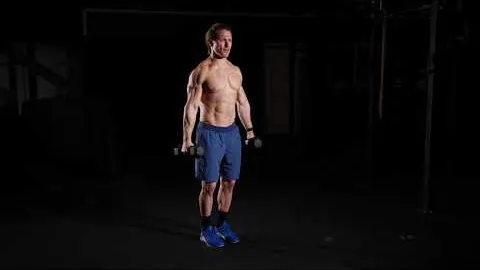
Want to build strong and defined shoulders? Look no further than the shoulder lateral raise exercise. This compound movement specifically targets the lateral head of the deltoid muscle, resulting in improved shoulder strength and stability. Whether you're a fitness enthusiast or a professional athlete, incorporating shoulder lateral raises into your workout routine can help you achieve a well-rounded and balanced physique. In this article, we will delve into the benefits, proper form, variations, and tips for maximizing the effectiveness of the shoulder lateral raise exercise.
Shoulder Strength: The shoulder lateral raise exercise primarily targets the lateral head of the deltoid muscle, which is responsible for lifting the arm away from the body. Strengthening this muscle helps improve overall shoulder strength and stability, making everyday activities and sports movements easier.
Muscle Definition: The lateral deltoid is the outermost part of the shoulder muscle group. By targeting this area with shoulder lateral raises, you can enhance muscle definition and create the sought-after "capped" shoulder look.
Improved Posture: Weak shoulder muscles can lead to poor posture and shoulder pain. Regularly performing shoulder lateral raises can help correct muscle imbalances, promote proper alignment, and alleviate discomfort caused by poor posture.
Injury Prevention: Strengthening the muscles around the shoulder joint, including the deltoids, can help protect against injuries such as shoulder impingement and rotator cuff strains. Incorporating shoulder lateral raises into your workout routine can help fortify these muscles and reduce the risk of injury.
Follow these steps to perform a shoulder lateral raise with proper form:
Starting Position: Stand tall with your feet shoulder-width apart, a slight bend in your knees, and a dumbbell in each hand. Maintain a neutral spine and engage your core for stability.
Lift: Keeping a slight bend in your elbows, exhale as you raise your arms straight out to the sides until they are parallel to the floor. Avoid hunching your shoulders or using momentum to lift the weights.
Hold: Pause for a brief moment at the top of the movement, ensuring that your arms are parallel to the floor and your palms are facing down.
Lower: Inhale as you slowly lower the weights back to the starting position, maintaining control throughout the descent.
Once you have mastered the basic shoulder lateral raise, you can progress to more advanced variations to continuously challenge your shoulders and further enhance their strength and definition. Here are a few variations to consider:
Seated Shoulder Lateral Raise: Sit on a bench or chair with your back straight and your core engaged. Perform the shoulder lateral raise movement while seated to isolate the shoulder muscles and prevent excessive swinging or cheating.
Single-arm Shoulder Lateral Raise: Hold a dumbbell or kettlebell in one hand instead of using both hands simultaneously. This challenges each shoulder independently and helps identify any imbalances between the right and left sides.
Resistance Band Lateral Raise: Attach a resistance band to a sturdy anchor point and hold the band handles in each hand. Perform the lateral raise movement against the resistance provided by the band, which increases the difficulty and activates additional stabilizing muscles.
Arnold Press: Begin with the weights at shoulder height, palms facing your body. As you raise the weights, rotate your palms outward until they face forward at the top of the movement. This variation adds an extra rotational element, targeting the front and side deltoids.
To ensure maximum effectiveness and safety during shoulder lateral raises, follow these tips:
Start with Light Weights: Begin with lighter weights to focus on mastering proper form and technique. As you become more comfortable, gradually increase the weight to challenge your muscles.
Maintain Control: Avoid swinging or using momentum to lift the weights. Focus on using your shoulder muscles to lift the weights in a controlled manner.
Mind-Muscle Connection: Concentrate on feeling the tension in your shoulder muscles throughout the movement. Visualize your deltoids contracting as you raise your arms.
Engage Your Core: Engaging your core muscles throughout the exercise helps stabilize your entire body and prevent unnecessary strain on your lower back.
Breathe: Remember to breathe naturally throughout the movement. Inhale as you lower the weights and exhale as you lift them.
In conclusion, the shoulder lateral raise exercise is a valuable addition to any shoulder-focused workout routine. By targeting the lateral head of the deltoid muscle, this exercise helps improve shoulder strength, definition, and stability. By following proper form, incorporating variations, and implementing the provided tips, you can maximize the effectiveness of shoulder lateral raises and achieve your desired shoulder strength and aesthetic. Regularly including this exercise in your workouts will support your overall shoulder health and help you develop a well-rounded physique.
If you're looking for a gym, fitness club or yoga studio, you've come to the right place.
You can find information about gyms in your area. Browse catalog of gyms and find gyms with classes which are you looking for.
On gym page you can find simple information like address, phone or website. You can find list of available classes. You can check availability of personal training or small group classes. On place page you can also see information about open hours.
You can find gyms near you with amenities, courts, studios and equipments.
Use our map to find gym at your city or district.
In Gym Navigator you can find list of exercises with movies for many body parts.
You can browse exercises catalog and find exercises the best of you.
You can also find exercises grouped into workout plans, which you can use to improve you body. Each routine show you exercises one by one and give you possibility to count you progress and count down rest time.